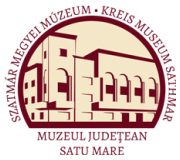Marta, Livius et al.: The Late Bronze Age Settlement of Nyíregyháza-Oros „Úr Csere” (Satu Mare, 2010)
VIII. Conclusions. Nyíregyháza-Oros site and its significance for the reearch of the Late Bronze Age
ner of ornamentation, its origin should be sought to the north, where the decoration made by dotted impressions is found in the Piliny cultural area346. The ornamentation of the neck through registers of impressions finds similarities among the vessels from a tumulus from the necropolis of Tápé347. The relationships between the settlement of Nyíregyháza-Oros and other contemporary sites, situated south of the Hajdfibagos-Cehăluţ cultural area, are also highlighted by some of the materials found here. As one could see in the chapter dedicated to the pottery, a series of ceramic forms are more numerous within the manifestations of the Igriţa group. Here it is mainly about biconic amphorae with out-curved rim belonging to the types 1, 4 and 6, all with good analogies within the environment of the above mentioned cultural group348. To these, we can add the cups with out-curved rim and flattened body (the IB variant), well documented in the Igriţa area too349. The Contribution of the Researches from Oros to the Knowledge of the Late Bronze Age in the Upper Tisa Area The research carried out at Nyíregyháza-Oros has brought up new elements with reference to the structure of a Hâjdubagos-Cehăluţ type settlement and to the shape of the complexes within it. It is one of the few settlements of this culture where an area delimited by a ditch, probably with defensive role, was identified350. A new element recognized for this cultural group is the identification of an area of ritual depositions located at the edge of the settlement, an important aspect that was revealed among other neighbouring cultures as well. The carrying out of some human activities within the settlement was highlighted and the osteologic analysis provided clues to how the community used to interact with the natural environment. The presence of numerous pieces of metal, and the statistical processing of a relatively large ceramic lot, offer clues to the evolution of the Hajdfibagos-Cehăluţ cultural group. Thus, the settlement of Oros can be dated to a late period of the evolution of the Hajdfibagos-Cehăluţ group, during 346 Kemenczei 1984, Pl. XI/13, XIII/3. 347 Trogmayer 1975, PI. 46/1-2. 348 Chidioşan-Emodi 1982, Pl. 1; Chidioşan-Emodi 1983, PI. 4/1; Emődi 1997, Pl. 1, 3. 349 Chidioşan-Emodi 1982, PI. 6/1-3; Chidioşan-Emodi 1983, PI. 6/6-9, 8/1; Emődi 1997, PI. 7/14-15. 350 Some recent researches have managed to identify the existence of some defensive structures (palisade) on a side of the Hâjdubagos-Cehăluţ settlement of Şimleu Silvaniei, too: researches, I. Bejinariu. 69
